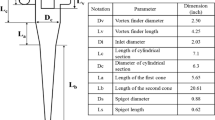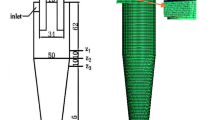Abstract
The flow behavior in hydrocyclones is quite complex. In this study, the computational fluid dynamics (CFD) method was used to simulate the flow fields inside a hydrocyclone in order to investigate its separation efficiency. In the computational fluid dynamics study of hydrocyclones, the air-core dimension is a key to predicting the mass split between the underflow and overflow. In turn, the mass split influences the prediction of the size classification curve. Three models, the \({k - \varepsilon}\) model, the Reynolds stress model (RSM) without considering the air-core, and the Reynolds stress turbulence model with the volume of fluid (VOF) multiphase model for simulating the air-core, were compared in terms of their predictions of velocity, axial and tangential velocity distributions, and separation proportion. The RSM with air-core simulation model, since it reproduces some detailed features of the turbulence and multiphase, clearly predicted the experimental data more closely than did the other two models.
Similar content being viewed by others
References
Bretney, E.: Water purifier. US Patent no. 543 105 (1891)
Kelsall D.F.: A study of the motion of solid particles in a hydraulic cyclone. Trans. Inst. Chem. Eng. 30, 87–108 (1952)
Kelsall D.F.: A further study on the hydraulic cyclone. Chem. Eng. Sci. 2, 254–272 (1953)
Bradley D.: The Hydrocyclone. Pergamon, London (1965)
Bloor M.I.G., Ingham D.B.: Theoretical investigation of the flow in a conical hydrocyclone. Trans. Inst. Chem. Eng. 51, 36–41 (1973)
Bloor M.I.G., Ingham D.B.: On the efficiency of the industrial cyclone. Trans. Inst. Chem. Eng. 51, 173–176 (1973)
Bloor M.I.G., Ingham D.B.: Turbulent spin in a cyclone. Trans. Inst. Chem. Eng. 53, 1–46 (1975)
Svarovsky L.: Hydrocyclones, 1st edn. Holt, Rinehart, and Winston, London (1984)
Barrientos, A., Sampaio, R., Concha, F.: Effect of the air core on the performance of a hydrocyclone. In: Proceedings XVIII International Mineral Processing Congress, pp. 267–270 (1993)
Rajamani R.K., Devulapalli B.: Hydrodynamic modeling of swirling flow and particle classification in large-scale-hydrocyclones. KONA 12, 95–104 (1994)
Ma L., Ingham D.B., Wen X.: Numerical modelling of the fluid and particle penetration through small sampling cyclones. J. Aerosol Sci. 31(9), 1097–1119 (2000)
Dyakowski T., Williams R.A.: Prediction of air-core size and shape in a hydrocyclone. Int. J. Miner. Process. 43, 1–14 (1995)
Fraser S.M., Abdel Rasek A.M., Abdullah M.Z.: Computational and experimental investigations in a cyclone dust separator. Proc. Inst. Grid. Engrs. 211E, 247–257 (1997)
He P., Salcudean M., Gartshore I.S.: A numerical simulation of hydrocyclones. Trans. Inst. Chem. Eng. 77, 429–441 (1999)
Suasnabar, D.J.: Dense Medium Cyclone Performance, enhancements via computational modeling of the physical process. Ph.D. Thesis, University of New South Wales (2000)
Schuetz S., Mayer G., Bierdel M., Piesche M.: Investigations on the flow and separation behaviour of hydrocyclones using computational fluid dynamics. Int. J. Miner. Process. 73, 229–23717 (2004)
Narasimha M., Sripriya R., Banerjee P.K.: CFD modelling of hydrocyclone—prediction of cut-size. Int. J. Miner. Process. 71(1), 53–68 (2005)
Launder B.E., Reece G.J., Rodi W.: Progress in the development of a Reynolds—stress turbulence closure. J. Fluid Mech. 68, 537–566 (1975)
Boysan F., Ayers W.H., Swithenbank J.: A fundamental mathematical modelling approach to cyclone design. Trans. Inst. Chem. Eng. 60, 222–230 (1982)
Cullivan J.C., Williams R.A., Cross C.R.: Understanding the hydrocyclone separator through computational fluid dynamics. Trans. Inst. Chem. Eng. 81A, 455–465 (2003)
Slack M.D., Prasad R.O., Bakker A., Boysan F.: Advances in cyclone modeling using unstructured grids. Trans. Inst. Chem. Eng. 78A, 1098–1104 (2000)
Brennan, M.S., Subramanian, V.J., Rong, R., Holtham, P.N., Lyman, G.J., Napier-Munn, T.J.: Towards a new understanding of the cyclone separator. In: Proceedings of XXII International Mineral Processing Congress. 29,September–3,October, Cape Town, South Africa (2003)
Delgadillo J.A., Rajamani R.K.: A comparative study of three turbulence-closure models for the hydrocyclone problem. Int. J. Miner. Process. 77(4), 217–230 (2005)
Hsieh, K.T.: A phenomenological model of the hydrocyclone. Ph.D. Thesis, University of Utah, USA (1988)
Speziale C.G., Sarkar S., Gatski T.B.: Modelling the pressurestrain correlation of turbulence. An invariant dynamical systems approach. J. Fluid Mech. 227, 245–274 (1991)
Castro, O., Concha, F.: Air core modeling for an industrial hydrocyclone. International Conference on Hydrocyclones’96, Cambridge, UK, 2–4 April, pp. 229–240 (1996)
Concha F., Barrientos A., Montero J., Sampio R.: Air core and roping in hydrocyclones. Int. J. Miner. Process. 44/45, 743–749 (1996)
Steffens P.R., Whiten W.J., Appleby S., Hitchins J.: Prediction of air core diameters for hydrocyclones. Int. J. Miner. Process. 39, 61–74 (1993)
Davidson, M.R.: A numerical model of liquid–solid flow in a hydrocyclone with high solids fraction. International Symposium Numerical Methods in Multiphase Flows. ASME FED-185, pp. 29–39 (1994)
Romero J., Sampaio R.: A numerical model for prediction of the air-core shape of hydrocyclone flow. Mech. Res. Commun. 26(3), 379–384 (1999)
Hsieh K.T., Rajamani R.K.: Mathematical model of the hydrocyclone based on the physics of fluid flow. AIChE J. 37, 735–746 (1991)
Malhotra A., Branion R.M.R., Hauptmann E.G.: Modeling the flow in a hydrocyclone. Can. J. Chem. Eng. 72, 953–960 (1994)
Davidson M.R.: Similarity solutions for flow in hydrocyclones. Chem. Eng. Sci. 43(7), 1499–1505 (1988)
Concha, F., Castro, B., Ovalle, E., Romero, J.: Numerical simulation of the flow pattern in a hydrocyclone. International Conference Innovation in Physical Separation Technology, Falmouth, UK, 4–5 June, pp. 35–60 (1998)
Pericleous K.A., Rhodes N.: The hydrocyclone classifier—a numerical approach. Int. J. Miner. Process. 17, 23–43 (1986)
Cullivan, J.C., Williams, R.A., Cross, C.R.: Verification of theoretical 3D-flow in a hydrocyclone using tomography. In: Proceedings 4th World Congress for Particle Technology, Sydney, pp. 1–9 (2000)
Brennan, M.S., Holtham, P.N., Rong, R., Lyman, G.J.: Computational fluid dynamic simulation of dense medium cyclones. In: Proceedings 9th Australian Coal Preparation Conference. Yeppoon Australia, 13–17 October Paper, vol. B3 (2002)
Devulapalli B., Rajamani R.K.: Application of LDV to the modelling of particle size classification in industrial hydrocyclones. ASME FED 191, 41–48 (1994)
Devulapalli, B., Rajamani, R.K.: A comprehensive CFD model for particle size classification in industrial hydrocyclones. Hydrocyclones 96, Cambridge UK, pp. 83–104 (1996)
Devulapalli, B.: Hydrodynamic modelling of solid–liquid flows in large scale hydrocyclones, Ph.D. Thesis, University of Utah (1997)
Baxter, L.L., Smith, P.J.: Turbulent dispersion of particles: the STP model. 7, 852–859 (1993)
Boivin M., Simonin O., Squires K.D.: On the prediction of gas–solid flows with two-way coupling using large eddy simulation. Phys. Fluids 12, 2080–2090 (2000)
Portela L.M., Oliemans R.V.A.: Direct and large eddy simulation of particle-laden flows using the point particle approach. In: Geurts, B.J. (eds) Direct and Large Eddy Simulation IV, pp. 53–460. Kluwer Academic, Dordrecht (2001)
Millelli M., Smith B.L., Lakehal D.: Large-eddy simulation of turbulent shear flows laden with bubbles. In: Geurts, B.J. (eds) Direct and Large Eddy Simulation IV, pp. 61–470. Kluwer Academic, Dordrecht (2001)
Ding J., Gidaspow D.: A bubbling fluidization model using kinetic theory of granular flow. AIChE J. 36, 523–528 (1990)
Gidaspow, D., Bezburuah, R., Ding, J.: Hydrodynamics of circulating fluidized beds, kinetic theory approach. In: Fluidization VII, Proceedings of the 7th Engineering Foundation Conference on Fluidization, pp 75–82 (1992)
Roco, M.C.: Particulate Two-Phase Flow. Butterworth-Heinemann, Boston (1993)
Clift R., Grace J.R., Weber M.E.: Bubbles, Drops and Particles. Academic Press, New York (1978)
Auton T.R.: The lift force on a spherical body in a rotational flow. J. Fluid Mech. 183, 199–218 (1987)
Stovin V.R., Saul A.J.: A computational fluid dynamics (CFD) particle tracking approach to efficiency prediction. Water Sci. Technol. 37(1), 285–293 (1998)
Nowakowski A.F., Cullivan J.C., Williams R.A., Dyakowski T.: Application of CFD to modelling of the flow in hydrocyclones. Is this a realizable option or still a research challenge?. Miner. Eng. 17, 661–669 (2004)
Author information
Authors and Affiliations
Corresponding author
Rights and permissions
About this article
Cite this article
Mousavian, S.M., Najafi, A.F. Numerical simulations of gas–liquid–solid flows in a hydrocyclone separator. Arch Appl Mech 79, 395–409 (2009). https://doi.org/10.1007/s00419-008-0237-2
Received:
Accepted:
Published:
Issue Date:
DOI: https://doi.org/10.1007/s00419-008-0237-2




